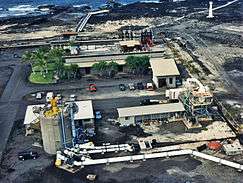Natural Energy Laboratory of Hawaii Authority
 | |
| Established | 1974 |
|---|---|
| Staff | 26 |
| Location |
|
| Campus | 870 acres (350 ha) |
Operating agency | State of Hawaii[1] |
| Website |
www |

| Part of a series on |
| Renewable energy |
|---|
The Natural Energy Laboratory of Hawaii Authority (NELHA) administers the Hawaii Ocean Science and Technology Park (HOST Park). NELHA was founded in 1974. At 870 acres (350 ha), HOST Park is perhaps the largest single green economic development project in the world solely devoted to growing a green economy. NELHA also administers a small site, 4 acres (1.6 ha), in Puna on the eastern side of the Island of Hawaii for geothermal research. The original mission was for research into the uses of Deep Ocean Water in Ocean thermal energy conversion (OTEC) renewable energy production and in aquaculture. It later added research into sustainable uses of natural energy sources such as solar energy. Its administration offices are located in the HOST Park Keahole Point in the North Kona District. The entrance is on the Hawaii Belt Road at coordinates 19°42′58″N 156°02′01″W / 19.71611°N 156.03361°WCoordinates: 19°42′58″N 156°02′01″W / 19.71611°N 156.03361°W, just south of the Kona International Airport. The main administration office is in the 4 acre research campus at the end of the road along the coastline on Keahole Point.
The laboratory was founded in 1974 with 345 acres (140 ha), associated with the University of Hawaii. Large pipelines pump cold sea water from a depth of 3,000 feet (910 m). For three months in 1979, a small amount of electricity was generated. A larger plant was constructed in the [2] Almost $250M was spent on Ocean thermal energy conversion, but by 1991, the research shifted to other areas. The adjacent Science and Technology Park was merged into the facility, expanding it to 877 acres (355 ha). A neutrino detector was partially constructed in the 1990s called Project DUMAND.[3]
In 2002, 50 acres (20 ha) were leased to a commercial company which filters and bottles the water for sale in Japan.[4] The pipelines were broken in the October 15, 2006 earthquake, but one of the three has been repaired over two years later. Makai Ocean Engineering, working with Lockheed Martin, restarted OTEC research.[5] Aquaculture, biofuel from algae, solar thermal energy, solar concentrating and wind power are some of the 40 tenants.[2]
See also
- West Hawai'i Explorations Academy, a charter school on the NELHA site
References
- ↑ http://hawaii.gov/
- 1 2 Revisiting NELHA in West Hawaii Today, April 26, 2009
- ↑ DUMAND web site at the University of Hawaii
- ↑ Natural Energy Lab ready for fresh start with DAGS in Honolulu Advertiser, May 31, 2009
- ↑ "Deep Pipelines for Ocean Thermal Energy Conversion" on Makai Ocean Engineering web site
External links
- Natural Energy Laboratory of Hawaii Official web site
- Friends of NELHA Web site describing the Hawaii Gateway Energy Center which is NELHA's visitor center